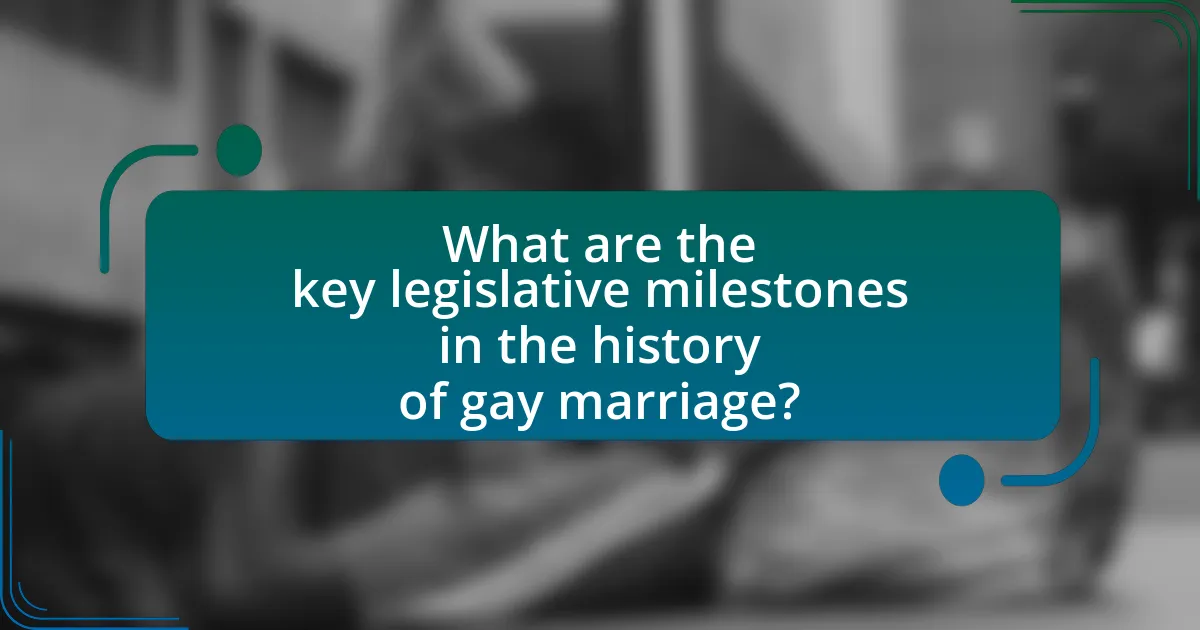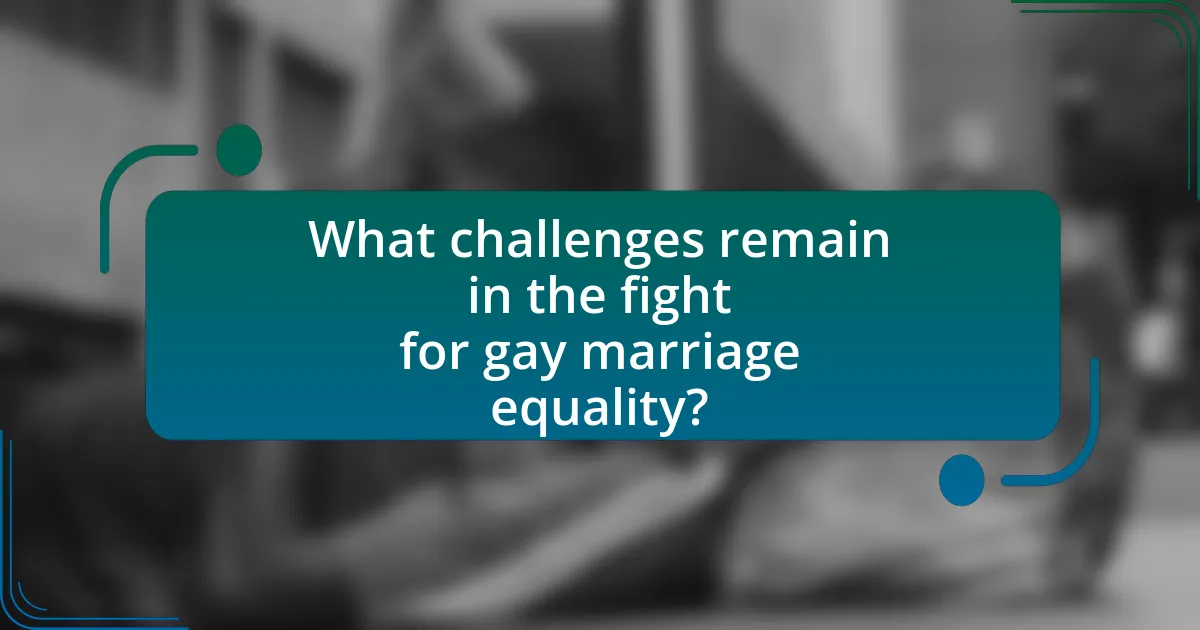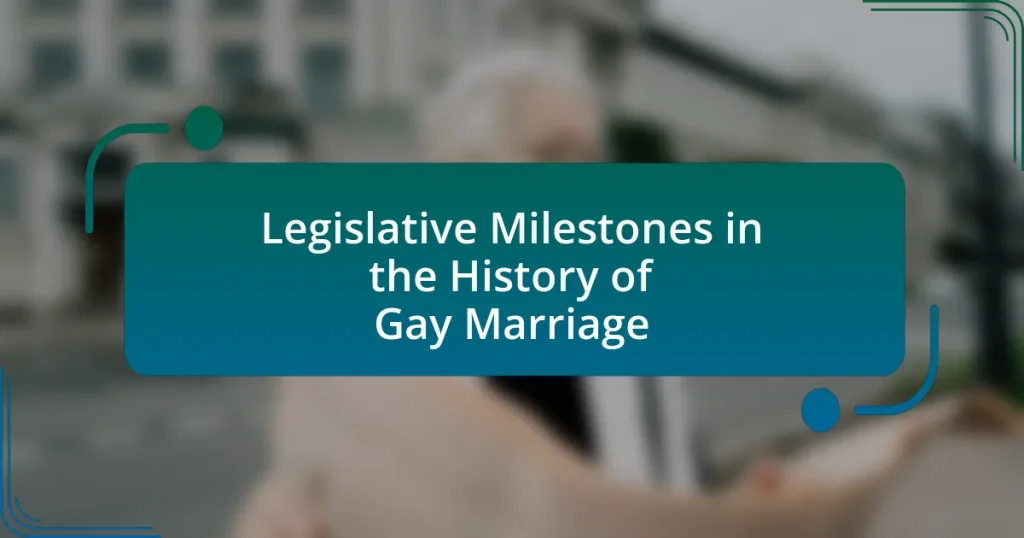The article examines the key legislative milestones in the history of gay marriage, highlighting significant events such as the Netherlands’ Marriage Act of 2001, Massachusetts’ legalization in 2004, and the U.S. Supreme Court’s 2015 ruling in Obergefell v. Hodges, which established same-sex marriage as a constitutional right. It discusses the impact of early legal battles, influential court cases, and the role of public opinion in shaping legislative efforts. Additionally, the article explores the influence of international perspectives, ongoing challenges, and strategies for advancing LGBTQ+ rights, providing a comprehensive overview of the evolution of gay marriage legislation globally and within the United States.

What are the key legislative milestones in the history of gay marriage?
The key legislative milestones in the history of gay marriage include the enactment of the Netherlands’ Marriage Act in 2001, which was the first law to legalize same-sex marriage. Following this, Massachusetts became the first U.S. state to legalize gay marriage in 2004 after a landmark Supreme Judicial Court ruling. In 2015, the U.S. Supreme Court’s decision in Obergefell v. Hodges established that same-sex marriage is a constitutional right across the United States, invalidating state bans. These milestones reflect significant legal advancements in the recognition of same-sex marriage globally and within the United States.
How did early legal battles shape the movement for gay marriage?
Early legal battles significantly shaped the movement for gay marriage by establishing legal precedents and raising public awareness. Landmark cases, such as Baker v. Nelson in 1971, challenged the constitutionality of state bans on same-sex marriage, prompting discussions about equal rights and discrimination. These early challenges laid the groundwork for future litigation, culminating in the U.S. Supreme Court’s decision in Obergefell v. Hodges in 2015, which legalized same-sex marriage nationwide. The legal arguments presented in these cases highlighted the importance of marriage equality as a civil right, influencing public opinion and mobilizing activists.
What were the significant court cases that influenced gay marriage legislation?
The significant court cases that influenced gay marriage legislation include Obergefell v. Hodges, United States v. Windsor, and Lawrence v. Texas. Obergefell v. Hodges, decided in 2015, established the constitutional right to same-sex marriage across the United States, affirming that state bans on same-sex marriage violated the Fourteenth Amendment’s Equal Protection and Due Process Clauses. United States v. Windsor, decided in 2013, struck down key provisions of the Defense of Marriage Act (DOMA), ruling that the federal government could not deny federal benefits to same-sex couples legally married in their states. Lawrence v. Texas, decided in 2003, invalidated sodomy laws, which laid the groundwork for later rulings on marriage equality by affirming the rights of same-sex couples to engage in private consensual conduct. These cases collectively advanced the legal recognition and rights of same-sex couples in the United States.
How did public opinion impact early legislative efforts for gay marriage?
Public opinion significantly influenced early legislative efforts for gay marriage by shifting the political landscape and encouraging lawmakers to support marriage equality. As societal attitudes evolved, particularly in the late 1990s and early 2000s, increasing acceptance of LGBTQ+ individuals led to greater public support for same-sex marriage. For instance, a 2004 Gallup poll indicated that 42% of Americans favored legalizing same-sex marriage, a notable increase from previous years. This growing support prompted some legislators to introduce bills and advocate for marriage equality, reflecting constituents’ changing views. Additionally, high-profile court cases, such as Goodridge v. Department of Public Health in Massachusetts in 2003, further galvanized public opinion and demonstrated the legal viability of same-sex marriage, ultimately influencing legislative actions in various states.
What role did state legislation play in the evolution of gay marriage rights?
State legislation significantly influenced the evolution of gay marriage rights by establishing legal frameworks that either recognized or denied same-sex marriage. For instance, Massachusetts became the first state to legalize gay marriage in 2004, setting a precedent that encouraged other states to consider similar measures. Over the following years, various states enacted laws or court rulings that expanded marriage rights, such as California’s legalization in 2008 and subsequent reinstatement in 2013. Conversely, some states passed constitutional amendments to ban same-sex marriage, reflecting the contentious nature of the issue. These legislative actions collectively shaped public opinion and laid the groundwork for the eventual Supreme Court ruling in Obergefell v. Hodges in 2015, which legalized same-sex marriage nationwide.
Which states were the first to legalize gay marriage and why?
Massachusetts was the first state to legalize gay marriage on May 17, 2004. The legalization occurred due to a ruling by the Massachusetts Supreme Judicial Court, which determined that denying same-sex couples the right to marry violated the state constitution’s guarantees of equal protection and due process. This landmark decision set a precedent for other states to follow in the subsequent years.
How did state-level decisions affect the national conversation on gay marriage?
State-level decisions significantly influenced the national conversation on gay marriage by setting precedents that shaped public opinion and legal frameworks. For instance, Massachusetts became the first state to legalize same-sex marriage in 2004, which sparked nationwide discussions and encouraged other states to consider similar legislation. This state-level action demonstrated the viability of same-sex marriage, leading to a domino effect where states like California and New York followed suit, further normalizing the concept and increasing visibility. Additionally, these decisions prompted national advocacy groups to mobilize, resulting in heightened media coverage and public discourse around LGBTQ+ rights, ultimately contributing to the Supreme Court’s landmark ruling in Obergefell v. Hodges in 2015, which legalized same-sex marriage nationwide.
What federal actions have been taken regarding gay marriage?
The federal actions taken regarding gay marriage include the Defense of Marriage Act (DOMA) enacted in 1996, which defined marriage as a union between one man and one woman, and the Supreme Court’s 2013 ruling in United States v. Windsor, which struck down key provisions of DOMA, allowing federal recognition of same-sex marriages. Additionally, the 2015 Supreme Court decision in Obergefell v. Hodges legalized same-sex marriage nationwide, affirming that state bans on same-sex marriage were unconstitutional under the Fourteenth Amendment. These actions collectively represent significant milestones in the legal recognition of gay marriage at the federal level.
What was the significance of the Defense of Marriage Act (DOMA)?
The Defense of Marriage Act (DOMA) was significant because it defined marriage for federal purposes as the union between one man and one woman, effectively denying federal recognition to same-sex marriages. Enacted in 1996, DOMA allowed states to refuse to recognize same-sex marriages performed in other states, which institutionalized discrimination against LGBTQ+ couples. The law was challenged in court, leading to the landmark Supreme Court case United States v. Windsor in 2013, which ruled that the federal government could not deny benefits to same-sex couples legally married under state law, thereby striking down key provisions of DOMA. This ruling marked a pivotal moment in the movement toward marriage equality in the United States.
How did the Supreme Court’s ruling in Obergefell v. Hodges change the landscape of gay marriage?
The Supreme Court’s ruling in Obergefell v. Hodges legalized same-sex marriage nationwide, fundamentally altering the legal landscape for gay marriage in the United States. This landmark decision, issued on June 26, 2015, established that the right to marry is guaranteed to same-sex couples under the Fourteenth Amendment, which ensures equal protection and due process. Prior to this ruling, same-sex marriage was only recognized in some states, leading to a patchwork of legal recognition. The Court’s decision effectively invalidated state bans on same-sex marriage, affirming that marriage is a fundamental right for all individuals, regardless of sexual orientation. This ruling not only provided legal recognition and protections for same-sex couples but also significantly advanced the broader LGBTQ+ rights movement by reinforcing the principle of equality under the law.

How have international perspectives influenced the legislative milestones of gay marriage?
International perspectives have significantly influenced the legislative milestones of gay marriage by providing models of legal recognition and advocacy that have inspired change in various countries. For instance, the legalization of same-sex marriage in the Netherlands in 2001 set a precedent that encouraged other nations to follow suit, leading to a domino effect across Europe and beyond. Countries such as Canada and Spain adopted similar laws shortly thereafter, demonstrating how international examples can catalyze domestic legislative efforts. Furthermore, international human rights organizations, such as the United Nations, have advocated for LGBTQ+ rights, framing them as fundamental human rights, which has pressured governments to reconsider their stances on gay marriage. This global dialogue has been pivotal in shaping public opinion and legislative agendas, ultimately contributing to the recognition of same-sex marriage in numerous jurisdictions worldwide.
What countries were pioneers in legalizing gay marriage?
The Netherlands was the first country to legalize gay marriage, doing so on April 1, 2001. Following the Netherlands, Belgium became the second country to legalize same-sex marriage on June 1, 2003. These countries set significant precedents in the global movement for marriage equality, influencing subsequent legislation in other nations.
How did these countries’ experiences differ from those in the United States?
Countries such as Canada and the Netherlands legalized same-sex marriage earlier than the United States, with Canada enacting its law in 2005 and the Netherlands in 2001, while the U.S. Supreme Court ruling in Obergefell v. Hodges occurred in 2015. These countries often had more progressive social attitudes and legal frameworks that facilitated the acceptance of same-sex marriage, contrasting with the U.S., where the issue faced significant political and religious opposition. For instance, public opinion in the Netherlands had shifted towards acceptance by the late 1990s, leading to legislative action, whereas in the U.S., the path to legalization involved a lengthy judicial process and state-by-state battles over marriage equality.
What lessons can be learned from international gay marriage legislation?
International gay marriage legislation teaches that legal recognition of same-sex marriage can significantly enhance social acceptance and equality for LGBTQ+ individuals. Countries that have legalized gay marriage, such as the Netherlands in 2001, have seen positive societal shifts, including increased visibility and rights for LGBTQ+ communities. Research indicates that legalizing same-sex marriage correlates with lower rates of mental health issues among LGBTQ+ individuals, as evidenced by studies published in journals like the American Journal of Public Health. Furthermore, the legislative process often involves public discourse that educates society on LGBTQ+ rights, fostering a more inclusive environment.
How has the global LGBTQ+ movement impacted legislative changes in gay marriage?
The global LGBTQ+ movement has significantly influenced legislative changes in gay marriage by advocating for equal rights and visibility, leading to legal recognition in numerous countries. Activism, public awareness campaigns, and legal challenges have pressured governments to reconsider and amend existing laws. For instance, the legalization of same-sex marriage in countries like the Netherlands in 2001 set a precedent that inspired similar changes worldwide, with over 30 countries following suit by 2023. Additionally, landmark court cases, such as Obergefell v. Hodges in the United States in 2015, were propelled by the movement’s efforts, resulting in the Supreme Court ruling that same-sex marriage is a constitutional right. These developments illustrate the direct correlation between the LGBTQ+ movement’s activism and the progressive changes in marriage legislation globally.
What role did international organizations play in advocating for gay marriage rights?
International organizations played a crucial role in advocating for gay marriage rights by promoting human rights standards that include sexual orientation and gender identity. Organizations such as the United Nations and the European Union have issued resolutions and reports emphasizing the importance of equality and non-discrimination, which have influenced national policies and legal frameworks. For instance, the UN’s Free & Equal campaign has raised awareness and mobilized support for LGBTQ+ rights globally, contributing to the legalization of same-sex marriage in various countries. Additionally, international treaties and conventions, such as the International Covenant on Civil and Political Rights, have been interpreted to support the rights of same-sex couples, reinforcing the legal basis for marriage equality.
How have cultural attitudes towards LGBTQ+ rights influenced legislative outcomes worldwide?
Cultural attitudes towards LGBTQ+ rights have significantly influenced legislative outcomes worldwide by shaping public opinion, which in turn pressures lawmakers to enact or reject laws related to LGBTQ+ rights. For instance, in countries where societal acceptance of LGBTQ+ individuals is high, such as in many Western nations, there has been a trend towards the legalization of same-sex marriage, as seen in the United States with the Supreme Court ruling in Obergefell v. Hodges in 2015, which legalized same-sex marriage nationwide. Conversely, in regions where cultural attitudes remain conservative, such as in parts of Africa and the Middle East, legislation often reflects these views, resulting in the criminalization of same-sex relationships and the absence of legal recognition for LGBTQ+ rights. This correlation between cultural attitudes and legislative outcomes is evident in various global surveys, such as the Pew Research Center’s findings, which indicate that public support for same-sex marriage correlates with increased legislative action in favor of LGBTQ+ rights.

What challenges remain in the fight for gay marriage equality?
Challenges that remain in the fight for gay marriage equality include ongoing legal battles, discrimination in various states, and the potential for legislative rollbacks. Despite the Supreme Court’s 2015 ruling in Obergefell v. Hodges, which legalized same-sex marriage nationwide, some states have enacted laws that undermine LGBTQ+ rights, such as allowing businesses to refuse service based on sexual orientation. Additionally, there are still significant disparities in legal protections for LGBTQ+ individuals, particularly in areas like adoption and healthcare. According to a 2021 report by the Human Rights Campaign, 29 states lack comprehensive non-discrimination protections for LGBTQ+ people, highlighting the persistent challenges in achieving full equality.
What legal obstacles still exist for same-sex couples in various jurisdictions?
Legal obstacles for same-sex couples still exist in various jurisdictions, including the lack of marriage recognition, adoption rights, and anti-discrimination protections. For instance, in some U.S. states, same-sex marriages are not recognized, which affects legal benefits such as tax filings and inheritance rights. Additionally, certain countries do not allow same-sex couples to adopt children, limiting their family-building options. Furthermore, in jurisdictions without comprehensive anti-discrimination laws, same-sex couples may face discrimination in employment, housing, and public services. These legal barriers highlight ongoing disparities in rights and protections for same-sex couples globally.
How do religious beliefs intersect with legislative efforts regarding gay marriage?
Religious beliefs significantly influence legislative efforts regarding gay marriage, often shaping public opinion and political agendas. For instance, many religious organizations oppose gay marriage based on traditional interpretations of marriage, which can lead to lobbying against pro-gay marriage legislation. This opposition was evident during the 2004 election in the United States, where religious groups mobilized to support state amendments banning same-sex marriage, resulting in 11 states passing such measures. Conversely, some religious groups advocate for LGBTQ+ rights, arguing that love and acceptance are core tenets of their faith, which has contributed to the legalization of gay marriage in various jurisdictions. The intersection of these beliefs and legislative actions illustrates the complex dynamics between faith, morality, and law in the ongoing debate over gay marriage.
What are the ongoing debates surrounding the rights of LGBTQ+ individuals in relation to marriage?
Ongoing debates surrounding the rights of LGBTQ+ individuals in relation to marriage primarily focus on the legal recognition of same-sex marriages, the implications of religious freedom laws, and the potential rollback of existing rights. Legal recognition remains contentious in various jurisdictions, with some states and countries seeking to restrict or redefine marriage laws, often citing traditional definitions. Additionally, debates arise over how religious institutions can exercise their beliefs in relation to marriage without infringing on the rights of LGBTQ+ individuals, as seen in cases where businesses refuse services for same-sex weddings. The U.S. Supreme Court’s 2015 decision in Obergefell v. Hodges, which legalized same-sex marriage nationwide, has not fully quelled opposition, as some lawmakers continue to propose amendments that could undermine this ruling. These discussions reflect broader societal attitudes towards LGBTQ+ rights and the intersection of civil liberties and religious beliefs.
What strategies can advocates use to promote further legislative progress?
Advocates can promote further legislative progress by employing grassroots mobilization, strategic coalition-building, and targeted lobbying efforts. Grassroots mobilization involves engaging the community through campaigns that raise awareness and encourage public participation, which can influence lawmakers by demonstrating widespread support. Strategic coalition-building allows advocates to unite various organizations and stakeholders, amplifying their collective voice and resources, as seen in successful campaigns for marriage equality that brought together LGBTQ+ groups, civil rights organizations, and faith-based communities. Targeted lobbying efforts focus on establishing relationships with key legislators, providing them with data and personal stories that highlight the importance of specific legislative measures, which has proven effective in past legislative victories, such as the passage of the Respect for Marriage Act in 2022.
How can grassroots movements effectively influence policy changes for gay marriage?
Grassroots movements can effectively influence policy changes for gay marriage by mobilizing community support, raising awareness, and engaging in strategic advocacy. These movements often utilize social media campaigns to disseminate information and rally public opinion, which can lead to increased visibility and pressure on lawmakers. For instance, the Human Rights Campaign’s “Marriage Equality” campaign successfully engaged millions of supporters, contributing to the legalization of same-sex marriage in multiple states. Additionally, grassroots organizations often collaborate with local leaders and activists to organize events, such as pride parades and rallies, which can demonstrate widespread support for gay marriage and influence policymakers. Historical examples, such as the 2015 Supreme Court decision in Obergefell v. Hodges, highlight how sustained grassroots efforts can culminate in significant legal changes, as public sentiment shifted dramatically in favor of marriage equality over the preceding decades.
What role does education play in advancing the conversation around gay marriage rights?
Education plays a crucial role in advancing the conversation around gay marriage rights by fostering understanding and empathy among individuals. Through comprehensive curricula that include LGBTQ+ history, rights, and issues, educational institutions can challenge stereotypes and promote acceptance. For instance, studies have shown that states with inclusive sex education programs report higher levels of support for gay marriage, indicating that informed individuals are more likely to advocate for equality. Furthermore, educational initiatives can empower advocates and allies, equipping them with the knowledge to engage in meaningful discussions and influence public opinion, thereby contributing to legislative changes that support gay marriage rights.


